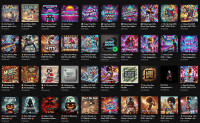Industry Set to Double by 2030
Introduction
The global audio streaming market is entering a new era of rapid expansion. Valued at approximately $40 billion in 2024, the industry is forecast to nearly double in size by 2030, reaching $89 billion with a compound annual growth rate (CAGR) of around 14%. This transformation is fueled by a mix of technological innovation, evolving consumer habits, and strategic moves from major platforms like Spotify, Apple Music, Amazon Music, Deezer, and emerging services.
- Introduction
- Market Growth Projections
- Key Drivers of Expansion
- 1. Global Adoption Beyond Western Markets
- 2. Rise of Podcasts and Spoken Word
- 3. Technological Innovation
- 4. Subscription + Ad-Supported Models
- Challenges Facing the Industry
- Regional Insights
- The Role of Emerging Platforms
- Looking Ahead: What 2030 Could Look Like
- Conclusion

Market Growth Projections
According to industry reports, the CAGR of 14% is one of the fastest within the entertainment sector. By 2030, the demand for music, podcasts, and spoken-word content will be stronger than ever.
- 2024 valuation: $40 billion
- 2030 projection: $89 billion
- Growth rate: CAGR ~14%
This growth highlights not only the financial opportunity but also the cultural impact of streaming as the default way people consume audio worldwide.
Key Drivers of Expansion
1. Global Adoption Beyond Western Markets
While North America and Europe remain important, the real surge is expected from Asia-Pacific, Latin America, and Africa. Affordable smartphones, cheaper data plans, and localized content strategies are opening doors for millions of new subscribers.
2. Rise of Podcasts and Spoken Word
Podcasts and audiobooks are no longer niche categories. Platforms like Spotify, YouTube Music, and Audible are heavily investing in exclusive content, pushing streaming far beyond music.
3. Technological Innovation
High-resolution audio (lossless, spatial, immersive formats) is becoming standard. AI-powered personalization, recommendation systems, and smart devices (from wearables to connected cars) are increasing engagement and retention.
4. Subscription + Ad-Supported Models
Freemium models continue to dominate, but hybrid monetization strategies (micro-subscriptions, premium exclusives, bundled offers with telecoms or video services) will ensure higher revenue per user.
Challenges Facing the Industry
Despite optimistic forecasts, the audio-streaming industry faces significant hurdles:
- Licensing Costs: High royalty payments remain a heavy burden for platforms.
- Fair Compensation: Artists are demanding more transparency and fairer payouts, with models like Deezer’s artist-centric approach and SoundCloud’s fan-powered royalties leading the debate.
- Market Saturation: With many players offering similar services, differentiation is essential.
- AI and Ethics: The rise of AI-generated music creates concerns about quality, authenticity, and fair distribution of royalties.
Regional Insights
- United States: Still the largest single market, though its share of global audio streaming revenues is expected to drop from ~31–43% to around 28–29% as other regions accelerate.
- Asia-Pacific: The fastest-growing region, with China, India, and Southeast Asia driving adoption.
- Europe: A mature but innovation-driven market, leading in experiments with new payout models and regulations.
- Latin America & Africa: Explosive growth potential, with younger populations and strong mobile-first consumption habits.
The Role of Emerging Platforms
New services are challenging the dominance of established giants:
- Coda Music positions itself as an “anti-algorithm” service, focusing on curated content rather than automated playlists.
- Regional streaming apps in India, Nigeria, and Brazil are winning audiences with local catalogs and cultural relevance.
This diversification strengthens the ecosystem and makes streaming more adaptable to cultural contexts.
Looking Ahead: What 2030 Could Look Like
By 2030, the audio streaming industry may no longer be defined just by access to songs. Instead, it will be a multimedia, multi-format hub that includes:
- Music
- Podcasts & audiobooks
- Live streaming events
- AI-driven interactive experiences
- Integrated social networking features
The projected $89 billion valuation is more than a financial milestone — it signals a global shift in how humans experience sound, storytelling, and culture.
Conclusion
The audio-streaming industry is on track to double its size by 2030, reshaping not only the music business but also the way billions of people around the world connect with audio. With opportunities in new markets, innovations in technology, and experiments in fairer compensation models, the next five years will be decisive. Whether you are an artist, investor, or listener, one thing is clear: the future of streaming is louder, broader, and more influential than ever.
![]()

















